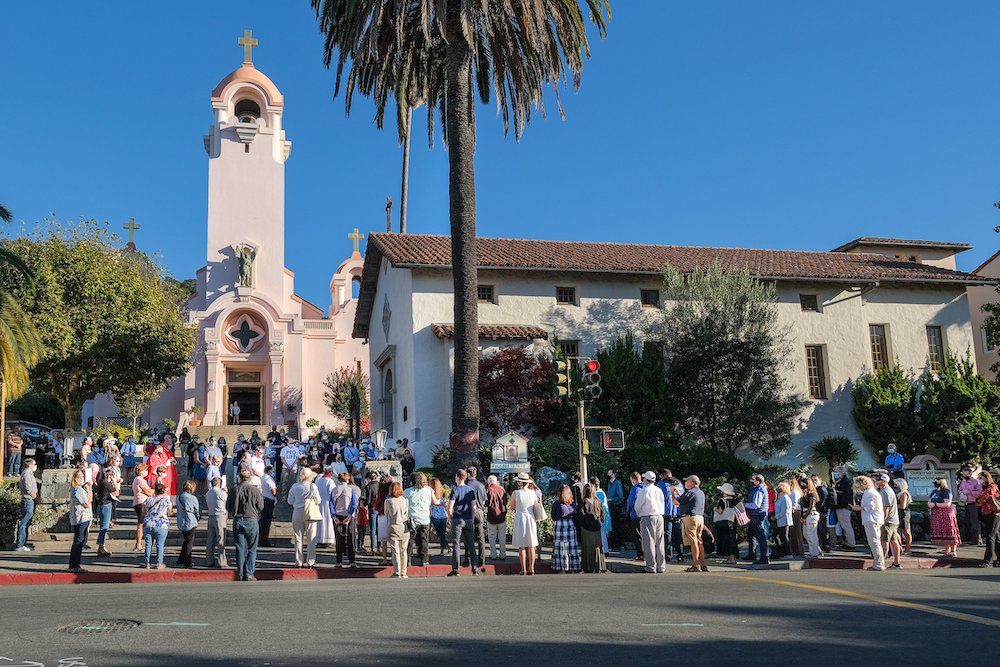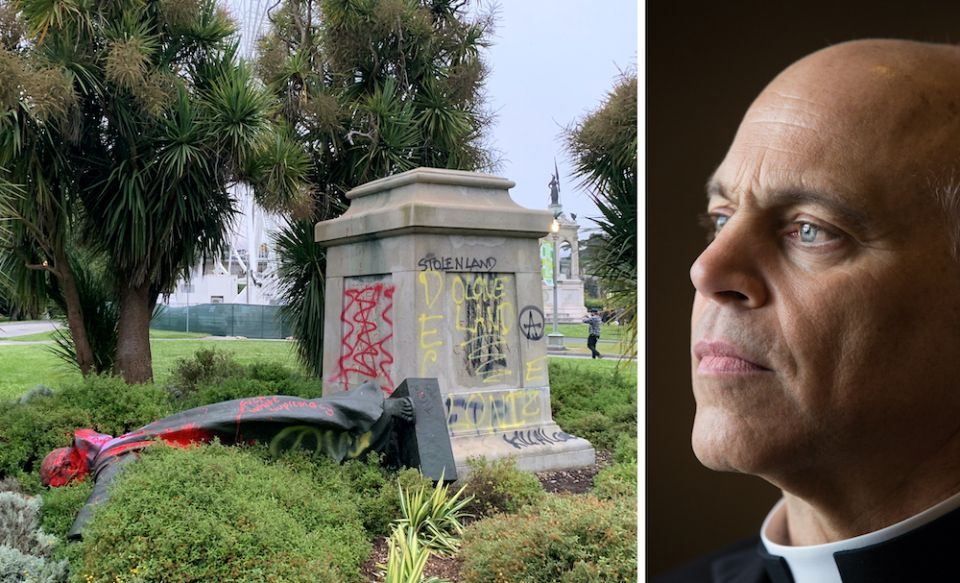
People in San Rafael, California, attend an exorcism Oct. 17, at Mission San Rafael conducted by San Francisco Archbishop Salvatore Cordileone. Vandals tore down a St. Junípero Serra statue there Oct. 12. (CNS/Archdiocese of San Francisco/Dennis Callahan)
Archbishop Salvatore Cordileone has faced several challenges since he became archbishop of San Francisco in 2012. They include a Supreme Court decision nullifying the Defense of Marriage Act that he championed; his failure to extract loyalty oaths on Catholic doctrine in hiring Catholic high school teachers; heavy blowback on his views on homosexuality; and his opposition to restrictions on Catholic worship he calls the work of "secular elites."
But his latest battle is against Satan, who he calls "the evil one." Cordileone performed the rite of exorcism as a response to the removal of statues of Franciscan missionary Junípero Serra at Golden Gate Park June 19, and later at Mission San Rafael, north of San Francisco on Oct. 12.
When the statues toppled, Cordileone sprang into action. Flanked by parishioners, priests and nuns praying the rosary, he conducted exorcisms at both places.
The prelate called the acts blasphemous and sacrilegious. He also demanded that the Marin County district attorney press felony and hate crime charges against the Native women who felled the statues. The district attorney filed felony vandalism but not hate crime charges against five people: Melissa Aguilar, Mayorgi Nadieska Delgadille, Victoria Eva Montano Pena, Moira Van de Walker and Andrew Lester Mendle.
The San Rafael protest was organized by the Coastal Miwok tribe based at the Graton Rancheria in Rohnert Park, California. Repeated efforts to reach Tribal Chairman Greg Sarris for comment were unsuccessful.
Cordileone dubbed the protests the work of a small, violent mob. "We cannot allow a small unelected group of lawbreakers to decide what sacred symbols we display to foster our faith," Cordileone said at the San Rafael exorcism.
Reactions varied from shock and anger directed against the vandals to suggestions that the exorcisms might be more appropriate at the Immigration and Customs Enforcement detention centers where immigrant children are kept in cages and the federal agency faces allegations that 16 women were sterilized without informed consent.
Since his arrival in San Francisco, Cordileone has shown himself a conservative counterpart to the reform-minded Pope Francis. The archbishop's description of contraception and homosexual acts as "gravely evil" and his demand for teacher loyalty oaths in 2015 led to a full-page ad in the San Francisco Chronicle from 100 Catholics calling for his ouster.
Cordileone, the grandson of an immigrant Sicilian fisherman, received a doctorate in canon law in Rome. He was ordained an auxiliary bishop of his native San Diego in 2002 and later appointed bishop of Oakland in 2009.
The American Catholic hierarchy's support of the Serra canonization in 2015 provoked strong reactions from Native Californians who said that Serra admitted to supervising whippings of their people for minor offenses. They also charge him with founding a mission system whose policies led to the deaths of 150,000 Natives from 1760 to 1834 though mass incarceration, disease and slave-like labor conditions.
Retired Sacramento Bishop Francis Quinn was the only member of the hierarchy to oppose the canonization, writing two letters urging Francis to cancel the ceremony. Quinn concelebrated a Mass for the Miwok people at Mission San Rafael in 2017, apologizing for the abuses of the Franciscans at the missions.
A priest exorcist who said his bishop did not wanted him quoted publicly by name said blasphemy is not an appropriate term when applied to statues, since it implies a direct insult to God. "It could be a desecration if the statue was blessed," he added, "but maybe Serra shouldn't have been canonized if the stories about him are true. The church should be doing due diligence on this."
Public opinion is divided. The Marin Independent Journal called the removal of the statue "mob rule … not civil disobedience, but disrespect for others' beliefs." Some letter writers strongly supported Cordileone's tough stance on the protesters.
Andrew Galvan, a member of the Ohlone and Miwok tribes who is among those who supported and participated in Serra's sainthood and canonization, told NCR in August that he understood the controversy surrounding Serra, but "defacing, destroying and removing Serra's statues is not the answer."

Left: A statue of Junípero Serra statue that was toppled June 19, in Golden Gate Park (CNS/Reuters/David Zandman; Right: San Francisco Archbishop Salvatore Cordileone (CNS/St. Louis Review/Lisa Johnston)
Others disagree.
"The exorcism was crazy and misleading," said Jesuit Fr. John Coleman, former Casassa professor of social values at Loyola Marymount University, Los Angeles, and associate pastor at St. Ignatius Church in San Francisco. "Serra was not an evil man, but he allowed a lot of bad things to happen, and this should be recognized."
A retired priest who ask not to be identified for fear of retaliation from conservative parishioners wrote in an email to NCR: "The recent exploitation of the rites of exorcism at sites where statues of Serra have been desecrated is consummately unwise. More wisdom can be gained from listening to our Native American brothers and sisters for whom Serra is a stumbling block to the church's credibility."
Michael Clement, a Southern California immigration activist, told NCR, "I think there are more worthy targets for exorcism such as the incarceration of children at the border and keeping them in cages."
Cordileone and Archbishop José Gomez of Los Angeles have made several statements that Native activists have called false and misleading.
Gomez is the president of the U.S. Conference of Catholic Bishops.
The colonial narrative, espoused by the Vatican, the U.S. Catholic bishops and the Franciscan order is that Serra was indeed a saint and the missions he founded were successful in converting the Natives and laying down the foundations of the "Golden State."
Native scholars and activists disagree. Author Sherburne Cook points out that the mission population declined from 1769 to 1832, from 72,000 to 18,000 people, with deaths exceeding births by 60%. Such widespread suffering and death, activists and scholars say, resulted in genocide and slavery, despite the good intentions of the Franciscans.
In particular, the scholars reject Gomez's claim in The Angelus, his diocesan newspaper, that "The crimes and abuse that our saint [Serra] is blamed for — slanders that are spread widely over the internet and sometimes repeated by public figures — actually happened long after his death.
California Lutheran University sociologist Jonathan Cordero, a member of the Ohlone tribe, disputes this and other Gomez statements. He has written that "these statues represent the fantasy heritage of California premised on the unacknowledged destruction of Native peoples and culture."
Advertisement
Others agree. "Things have not changed for the Catholic Church in 250 years," activist and organizer Gregg Castro, of the Salinan and Ohlone tribes, told NCR. "Exorcisms are a throwback to the thinking of the 1700s, which justified what the Spaniards did to us. To them we are some kind of demonic spirits."
Castro said the protests against the statues are signs of Indigenous reawakening. "Up until now we have been dealing with our traumas from the past. But the occupation of Alcatraz Island in the 1970s and the Standing Rock protests have empowered the young to speak out about how their ancestors were treated.
Shawnee and Lenape scholar Steven T. Newcomb of the Indigenous Law Institute is an expert on the Doctrine of Discovery, the blueprint for the colonization of the Americas. Newcomb, author of Pagans in the Promised Land, has written that 12 medieval papal "bulls" laid the groundwork for Spain and Portugal to invade and establish domination on pagan lands. "Those who resisted could be enslaved and eradicated and their lands taken from them," Newcomb told NCR.
Newcomb reacted to the archbishop's characterization of the statue removals as "the act of the evil one."
"What is really evil is the system of domination that Serra helped impose with the missions," he said.
"The deaths and destruction experienced by the native peoples during the mission period and the effort to eradicate their languages, cultures and free way of life — that was evil and malicious," Newcomb said.
Cordileone responded by email when asked whether or not exorcism was an extreme measure to take regarding the statue removals. "A minor exorcism is not extreme," the archbishop wrote in a statement to NCR. "Catholics experienced this attack as a wound to the soul that needed to be healed. The perpetrators need to make a sincere apology for their criminal actions as a sign of good will."
[Mark R. Day covered the West Coast for NCR in the 1980s. He is a former Franciscan friar who lived and studied at three California missions. Day is currently writing a book on telling the truth about the missions. He can be reached by email at mday700@yahoo.com.]




